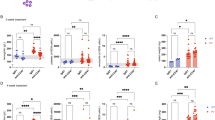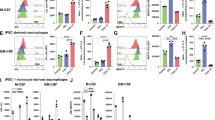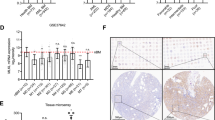Abstract
While a number of extrinsic factors are known to promote the survival of plasma cells (PCs), the signaling intermediates involved remain poorly characterized. Here we identified inducible nitric oxide synthase (iNOS) as an intermediate that supported the survival of PCs. PCs deficient in iNOS (Nos2−/− PCs) showed enhanced death in vitro, after transfer into congenic adoptive hosts, and in chimeras made with wild-type and Nos2−/− bone marrow. The iNOS-mediated protection involved activation of protein kinase G and modulation of endoplasmic reticulum stress components. Activation of caspases was also diminished. We found that iNOS was required for PCs to respond to some prosurvival mediators associated with bone marrow stromal cells and that at least one mediator, interleukin 6, fed directly into this pathway by inducing iNOS.
This is a preview of subscription content, access via your institution
Access options
Subscribe to this journal
Receive 12 print issues and online access
$209.00 per year
only $17.42 per issue
Buy this article
- Purchase on Springer Link
- Instant access to full article PDF
Prices may be subject to local taxes which are calculated during checkout






Similar content being viewed by others
References
Vieira, P. & Rajewsky, K. The half-lives of serum immunoglobulins in adult mice. Eur. J. Immunol. 18, 313–316 (1988).
van Anken, E. et al. Sequential waves of functionally related proteins are expressed when B cells prepare for antibody secretion. Immunity 18, 243–253 (2003).
Gass, J.N., Jiang, H.Y., Wek, R.C. & Brewer, J.W. The unfolded protein response of B-lymphocytes: PERK-independent development of antibody-secreting cells. Mol. Immunol. 45, 1035–1043 (2008).
Ho, F., Lortan, J.E., MacLennan, I.C. & Khan, M. Distinct short-lived and long-lived antibody-producing cell populations. Eur. J. Immunol. 16, 1297–1301 (1986).
Manz, R.A., Thiel, A. & Radbruch, A. Lifetime of plasma cells in the bone marrow. Nature 388, 133–134 (1997).
Slifka, M.K. & Ahmed, R. Long-lived plasma cells: a mechanism for maintaining persistent antibody production. Curr. Opin. Immunol. 10, 252–258 (1998).
Hetz, C. et al. Proapoptotic BAX and BAK modulate the unfolded protein response by a direct interaction with IRE1α. Science 312, 572–576 (2006).
Minges Wols, H.A., Underhill, G.H., Kansas, G.S. & Witte, P.L. The role of bone marrow-derived stromal cells in the maintenance of plasma cell longevity. J. Immunol. 169, 4213–4221 (2002).
Cassese, G. et al. Plasma cell survival is mediated by synergistic effects of cytokines and adhesion-dependent signals. J. Immunol. 171, 1684–1690 (2003).
O'Connor, B.P. et al. BCMA is essential for the survival of long-lived bone marrow plasma cells. J. Exp. Med. 199, 91–98 (2004).
Belnoue, E. et al. APRIL is critical for plasmablast survival in the bone marrow and poorly expressed by early-life bone marrow stromal cells. Blood 111, 2755–2764 (2008).
Chevrier, S. et al. CD93 is required for maintenance of antibody secretion and persistence of plasma cells in the bone marrow niche. Proc. Natl. Acad. Sci. USA 106, 3895–3900 (2009).
Rozanski, C.H. et al. Sustained antibody responses depend on CD28 function in bone marrow-resident plasma cells. J. Exp. Med. 208, 1435–1446 (2011).
Xiang, Z. et al. FcgammaRIIb controls bone marrow plasma cell persistence and apoptosis. Nat. Immunol. 8, 419–429 (2007).
Rodriguez Gomez, M. et al. Basophils support the survival of plasma cells in mice. J. Immunol. 185, 7180–7185 (2010).
Chu, V.T. et al. Eosinophils are required for the maintenance of plasma cells in the bone marrow. Nat. Immunol. 12, 151–159 (2011).
Jang, E. et al. Foxp3+ regulatory T cells control humoral autoimmunity by suppressing the development of long-lived plasma cells. J. Immunol. 186, 1546–1553 (2011).
Salgo, M.G., Squadrito, G.L. & Pryor, W.A. Peroxynitrite causes apoptosis in rat thymocytes. Biochem. Biophys. Res. Commun. 215, 1111–1118 (1995).
Loweth, A.C., Williams, G.T., Scarpello, J.H. & Morgan, N.G. Evidence for the involvement of cGMP and protein kinase G in nitric oxide-induced apoptosis in the pancreatic B-cell line, HIT-T15. FEBS Lett. 400, 285–288 (1997).
Choi, B.M., Pae, H.O., Jang, S.I., Kim, Y.M. & Chung, H.T. Nitric oxide as a pro-apoptotic as well as anti-apoptotic modulator. J. Biochem. Mol. Biol. 35, 116–126 (2002).
Genaro, A.M., Hortelano, S., Alvarez, A., Martinez, C. & Bosca, L. Splenic B lymphocyte programmed cell death is prevented by nitric oxide release through mechanisms involving sustained Bcl-2 levels. J. Clin. Invest. 95, 1884–1890 (1995).
Liu, L. & Stamler, J.S.N.O. an inhibitor of cell death. Cell Death Differ. 6, 937–942 (1999).
Kim, Y.M. et al. Nitric oxide prevents tumor necrosis factor α-induced rat hepatocyte apoptosis by the interruption of mitochondrial apoptotic signaling through S-nitrosylation of caspase-8. Hepatology 32, 770–778 (2000).
Kitiphongspattana, K. et al. Protective role for nitric oxide during the endoplasmic reticulum stress response in pancreatic beta-cells. Am. J. Physiol. Endocrinol. Metab. 292, E1543–E1554 (2007).
Guo, F., Lin, E.A., Liu, P., Lin, J. & Liu, C. XBP1U inhibits the XBP1S-mediated upregulation of the iNOS gene expression in mammalian ER stress response. Cell. Signal. 22, 1818–1828 (2010).
Yu, X., Kennedy, R.H. & Liu, S.J. JAK2/STAT3, not ERK1/2, mediates interleukin-6-induced activation of inducible nitric-oxide synthase and decrease in contractility of adult ventricular myocytes. J. Biol. Chem. 278, 16304–16309 (2003).
Kolb, J.P. Mechanisms involved in the pro- and anti-apoptotic role of NO in human leukemia. Leukemia 14, 1685–1694 (2000).
Xu, W., Liu, L., Charles, I.G. & Moncada, S. Nitric oxide induces coupling of mitochondrial signalling with the endoplasmic reticulum stress response. Nat. Cell Biol. 6, 1129–1134 (2004).
Matsuyama, S., Llopis, J., Deveraux, Q.L., Tsien, R.Y. & Reed, J.C. Changes in intramitochondrial and cytosolic pH: early events that modulate caspase activation during apoptosis. Nat. Cell Biol. 2, 318–325 (2000).
Li, J., Billiar, T.R., Talanian, R.V. & Kim, Y.M. Nitric oxide reversibly inhibits seven members of the caspase family via S-nitrosylation. Biochem. Biophys. Res. Commun. 240, 419–424 (1997).
Li, J., Yang, S. & Billiar, T.R. Cyclic nucleotides suppress tumor necrosis factor alpha-mediated apoptosis by inhibiting caspase activation and cytochrome c release in primary hepatocytes via a mechanism independent of Akt activation. J. Biol. Chem. 275, 13026–13034 (2000).
Kim, Y.M. et al. Nitric oxide protects PC12 cells from serum deprivation-induced apoptosis by cGMP-dependent inhibition of caspase signaling. J. Neurosci. 19, 6740–6747 (1999).
Auner, H.W., Beham-Schmid, C., Dillon, N. & Sabbattini, P. The life span of short-lived plasma cells is partly determined by a block on activation of apoptotic caspases acting in combination with endoplasmic reticulum stress. Blood 116, 3445–3455 (2010).
Earnshaw, W.C., Martins, L.M. & Kaufmann, S.H. Mammalian caspases: structure, activation, substrates, and functions during apoptosis. Annu. Rev. Biochem. 68, 383–424 (1999).
Hotamisligil, G.S. Endoplasmic reticulum stress and the inflammatory basis of metabolic disease. Cell 140, 900–917 (2010).
Shaffer, A.L. et al. XBP1, downstream of Blimp-1, expands the secretory apparatus and other organelles, and increases protein synthesis in plasma cell differentiation. Immunity 21, 81–93 (2004).
Rutkowski, D.T. et al. Adaptation to ER stress is mediated by differential stabilities of pro-survival and pro-apoptotic mRNAs and proteins. PLoS Biol. 4, e374 (2006).
Gunn, K.E. & Brewer, J.W. Evidence that marginal zone B cells possess an enhanced secretory apparatus and exhibit superior secretory activity. J. Immunol. 177, 3791–3798 (2006).
Skalet, A.H. et al. Rapid B cell receptor-induced unfolded protein response in nonsecretory B cells correlates with pro- versus antiapoptotic cell fate. J. Biol. Chem. 280, 39762–39771 (2005).
Ron, E. et al. Bypass of glycan-dependent glycoprotein delivery to ERAD by up-regulated EDEM1. Mol. Biol. Cell 22, 3945–3954 (2011).
Gotoh, T. & Mori, M. Nitric oxide and endoplasmic reticulum stress. Arterioscler. Thromb. Vasc. Biol. 26, 1439–1446 (2006).
Hsieh, Y.H. et al. Differential endoplasmic reticulum stress signaling pathways mediated by iNOS. Biochem. Biophys. Res. Commun. 359, 643–648 (2007).
Zong, W.X. et al. Bax and Bak can localize to the endoplasmic reticulum to initiate apoptosis. J. Cell Biol. 162, 59–69 (2003).
Pelletier, N. et al. The endoplasmic reticulum is a key component of the plasma cell death pathway. J. Immunol. 176, 1340–1347 (2006).
Chatterjee, P., Tiwari, R.K., Rath, S., Bal, V. & George, A. Modulation of antigen presentation and B cell receptor signaling in B cells of beige mice. J. Immunol. 188, 2695–2702 (2012).
Mukhopadhyay, S., George, A., Bal, V., Ravindran, B. & Rath, S. Bruton's tyrosine kinase deficiency in macrophages inhibits nitric oxide generation leading to enhancement of IL-12 induction. J. Immunol. 163, 1786–1792 (1999).
Chang, S., Chen, W. & Yang, J. Another formula for calculating the gene change rate in real-time RT-PCR. Mol. Biol. Rep. 36, 2165–2168 (2009).
Acknowledgements
We thank R. Kumar for assistance with flow cytometry, and I. Singh for help with breeding and maintenance of mouse strains. Supported by the Department of Biotechnology of the Government of India (BT/PR-14592/BRB/10/858/2010 to S.R.; BT/PR10954/BRB/10/625/2008 and BT/PR12849/MED/15/35/2009 to A.G.; and support for the National Institute of Immunology) and the Department of Science and Technology of the Government of India (SR/SO/HS-0005/2011 to V.B.).
Author information
Authors and Affiliations
Contributions
A.S.S. and G.N.S. did experiments and helped in their design and analysis; A.S.S. contributed to manuscript preparation; and S.R., V.B. and A.G. designed and planned the experiments, analyzed and interpreted data and wrote the manuscript.
Corresponding author
Ethics declarations
Competing interests
The authors declare no competing financial interests.
Integrated supplementary information
Supplementary Figure 1 Effect of iNOS deficiency on B cell differentiation.
(a) Frequency of plasma cells 96 h after stimulation of B cells with anti-IgM. Representative of 3 experiments (b) Upregulation of activation markers by wild-type (black) and Nos2−/− (red) B cells stimulated with 10 μg/ml LPS. Dotted lines: unstimulated cells. Shaded histogram: unstained cells. (c) Proliferation of B cells in response to LPS and anti-IgM stimulation for 48 h. Representative of 4 experiments. (d) Identification of plasma cells in bone marrow (BM, representative of 3 plots) and in spleens of mice 96 h after intraperitoneal injection of 50 μg LPS (representative of 15 plots), for sorting. WT: wild-type, KO: Nos2−/−
Supplementary Figure 2 iNOS deficiency does not affect B cell proliferation.
(a) CFSE dilution profiles of live-gated B cells that were stimulated for 48, 72 or 96 h with 10 μg/ml LPS (representative of 3 independent experiments). (b) Number of cells in each division cycle (mean +/- SE of 3 independent experiments). WT: wild-type, KO: Nos2−/−
Supplementary Figure 3 iNOS deficiency does not affect B cell differentiation.
Modulation of transcript abundance of genes known to be involved in terminal differentiation of B cells (a) and kinetics of plasma cell generation (b) scored over time following stimulation of IgD+ cells with 10 μg/ml LPS. Fold expression in (a) is calculated relative to wild-type at 0 h. Numbers in (b) represent frequency of plasma cells. Data are mean +/- SE of 3 experiments. WT: wild-type, KO: Nos2−/−
Supplementary Figure 4 Estimation of plasma cell viability by flow cytometry.
Sort-purified plasma cells from wild-type (WT) and Nos2−/− (KO) mice were cultured in vitro and death estimated over time by Sytox positivity. Data are representative of 2 experiments. Numbers above gates indicate percentage of dead cells.
Supplementary Figure 5 iNOS deficiency does not affect ROS levels or mitochondrial potential during B cell differentiation.
(a) Effect of addition of N-acetyl cysteine on plasma cell frequencies in vitro. Numbers in plots represent frequency. Plots are representative of 2 experiments (b) Estimation of intracellular ROS levels in wild-type (black line) and Nos2−/− (red line) plasma cells. Shaded histogram: Unstained cells. Data are representative of 3 experiments (c) Estimation of mitochondrial mass and potential in wild-type (WT) and Nos2−/− (KO) plasma cells. Data are representative of 5 experiments.
Supplementary Figure 6 Activated caspases in live-gated B220loCD138+ cells following stimulation of wild-type (WT) and Nos2−/− (KO) splenocytes with 10 μg/ml LPS for 96 h.
Plots are representative of 4 experiments. Numbers above gates indicate the proportion of cells expressing activated caspases.
Supplementary information
Supplementary Text and Figures
Supplementary Figures 1–6 (PDF 10487 kb)
Rights and permissions
About this article
Cite this article
Saini, A., Shenoy, G., Rath, S. et al. Inducible nitric oxide synthase is a major intermediate in signaling pathways for the survival of plasma cells. Nat Immunol 15, 275–282 (2014). https://doi.org/10.1038/ni.2806
Received:
Accepted:
Published:
Issue Date:
DOI: https://doi.org/10.1038/ni.2806
This article is cited by
-
B cell depletion therapies in autoimmune disease: advances and mechanistic insights
Nature Reviews Drug Discovery (2021)
-
Arginine-dependent immune responses
Cellular and Molecular Life Sciences (2021)
-
Macrophage, the potential key mediator in CAR-T related CRS
Experimental Hematology & Oncology (2020)
-
CAR T cell–induced cytokine release syndrome is mediated by macrophages and abated by IL-1 blockade
Nature Medicine (2018)
-
K562 chronic myeloid leukemia cells modify osteogenic differentiation and gene expression of bone marrow stromal cells
Journal of Cell Communication and Signaling (2018)



